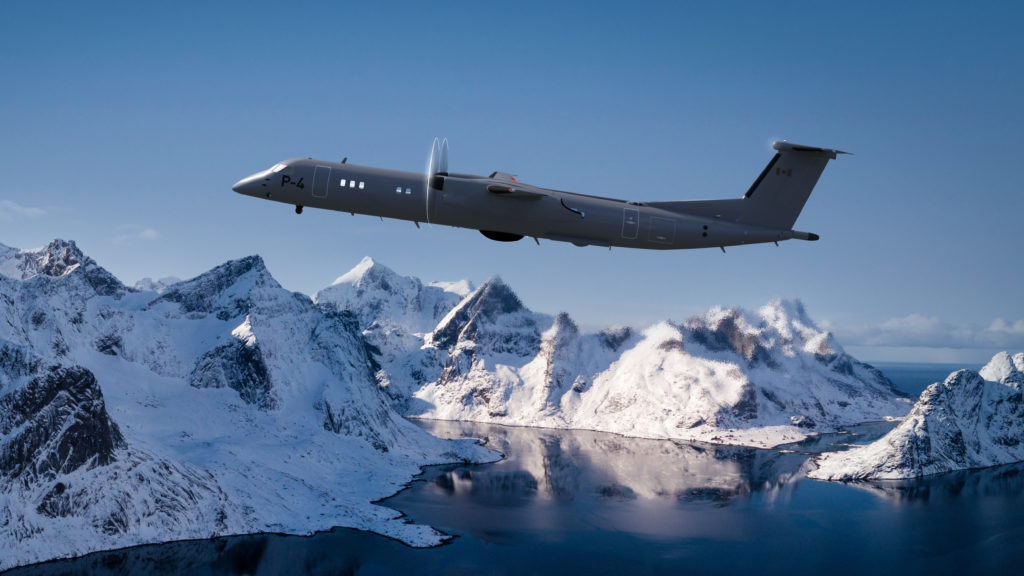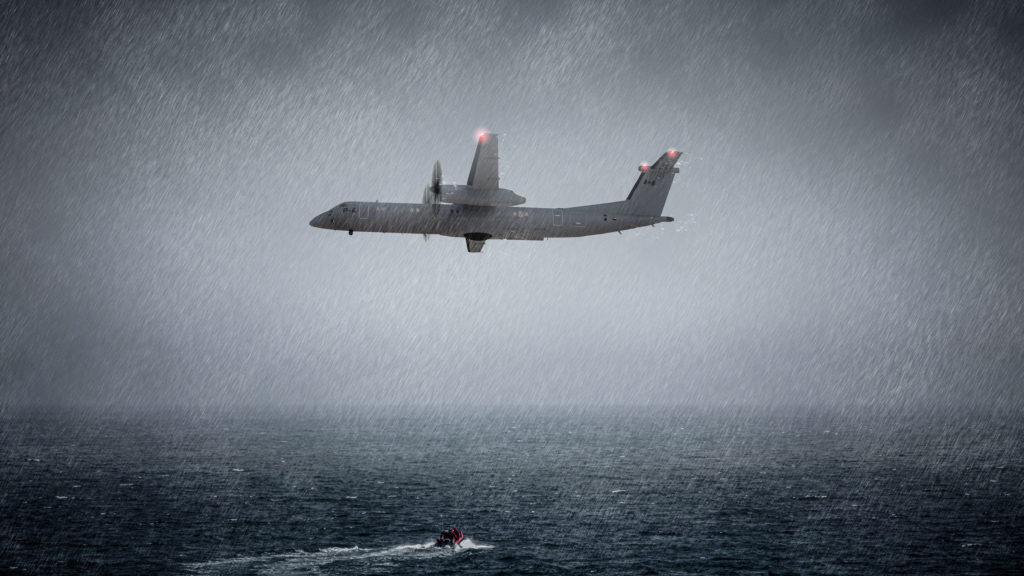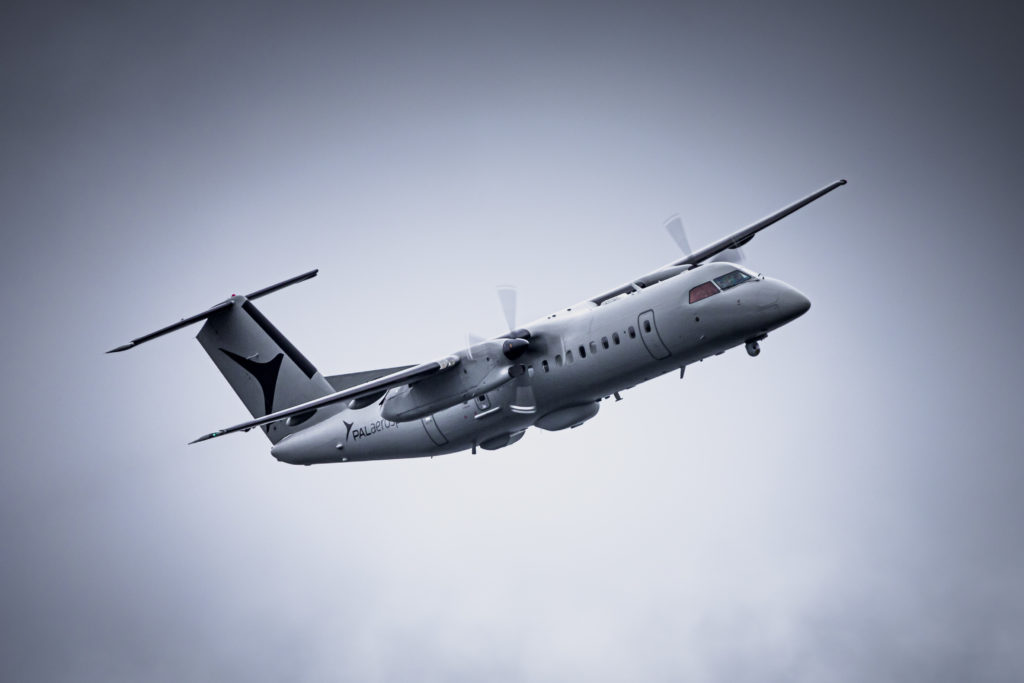Estimated reading time 15 minutes, 35 seconds.
When PAL Aerospace and De Havilland Canada (DHC) announced a memorandum of understanding in February to jointly develop a multi-role maritime patrol and intelligence, surveillance and reconnaissance (ISR) aircraft, very few eyebrows were raised.
Afterall, PAL has been missionizing and operating patrol and surveillance aircraft for customers around the world for the better part of 40 years, and the majority of their contracts are based on the venerable DHC Dash 8 platform. A new venture between the two Canadian companies was hardly a surprise.
But pursuit of long-range patrol and surveillance opportunities with a fully missionized Dash 8-400 turboprop probably warrants a closer look. Because if the two companies have done their homework, the P-4 could be a market disruptor.

The aircraft name itself is a nod to its next-generation potential as a successor to the iconic Lockheed P-3 Orion, and variants that have been in service since the 1960s as the leading platforms for maritime patrol (MPA), anti-submarine and anti-surface warfare, surveillance, counter-narcotics, fishery monitoring, and other missions. The P-4 is also being positioned as a complement to a wider network of manned, unmanned, and space-based surveillance systems that many Western nations are now developing to meet domestic and international ISR requirements.
The first comprehensive Dash 8 P-4 technical solution could be unveiled as early as this fall. The aircraft has been down selected for the Royal Malaysian Air Force maritime surveillance program, and a contract award is anticipated in the fourth quarter of 2021.
While the specific capabilities of each P-4 will be defined by the customer, modifying the Dash 8 is comfortable terrain for PAL. The St. John’s, Newfoundland-based company is one of the largest De Haviland aircraft operators in Canada, and has designed many of its global contractor-operated programs around the platform. The longest running, with the federal Department of Fisheries and Oceans (DFO), involves fisheries patrols and marine resource management conducted with two modified Dash 8-100s. The company provides coastal patrols for the Dutch Caribbean Coast Guard, operating out of Curacao with two Dash 8-100s, and recently won a contract to provide similar services for the Netherlands Coast Guard. It is also flying contracted maritime patrol for the United Arab Emirates with two sensor-loaded Dash 8-300s.
“A lot of our bread and butter is contractor owned, contractor operated missions,” said Phil Garbutt, PAL’s senior vice president of global support, and a former aerospace engineering officer with 32 years of service in the Royal Canadian Air Force (RCAF). “We have a great collaborative relationship with De Havilland from a missionized aircraft perspective.”
The appeal of the Dash 8-400 platform for a diversified set of missions can be attributed to a number of factors, Garbutt explained, but the bottom line is speed, power, and performance. “The Dash 8 is a turboprop that operates like a jet,” he said. “It really is the best in class for its size and capacity. And it is remarkably well suited for the specialized mission environment.”
For Philippe Poutissou, DHC vice president of sales and marketing, the appeal has more to do with the Dash 8’s reliability and versatility. With over 600 Dash 8-400s delivered into commercial operations, the aircraft has accumulated the flying hours and maintenance track record to assure potential customers of its dependability. It’s also proven as an effective platform operating in high mountainous altitudes, in extreme cold and hot weather conditions, and from austere airfields. “It is a very robust and rugged airframe, so it can operate off gravel strips and on snow and ice,” he noted.
The Dash 8-400 features a long, uninterrupted fuselage with significant payload capacity and, because the landing gear is mounted on the wings, an underbelly available for antennas, sensor pods, cameras or conformal tanks.
“The flight deck and navigation equipment that comes out of the box has evolved as technology has become available for commercial markets,” Poutissou added of the Thales cockpit. “So you start from a modern baseline and you can build on to meet whatever specialized mission you are performing.”
The P-4 partnership comes at the right time for DHC. The De Havilland Canada brand, acquired by Longview Aviation Capital from Bombardier in November 2018, is finding new wings as a more independent entity. And the Dash 8 series, in production since 1984, has reached a level of commercial maturity where the company is looking to “expand market opportunities,” said Poutissou.
Perhaps as a result of the pandemic, demand for new Dash 8s from commercial operators has declined, but interest in the special mission market is gaining traction, he noted. Companies such as Conair Aerial Firefighting, Conoco Phillips, and Cobham Aviation Services in Australia are seeking modifications for specialized roles.
“We are seeing diversification of operations,” he said. “That is really good for the program. We would like to see this MPA and ISR mission with the P-4 expand the mission set for the Dash 8-400.”
POTENTIAL P-3 REPLACEMENT
PAL and DHC see the P-4 as a potential differentiator for long range patrol and other specialized missions. Powered by Pratt and Whitney Canada engines, the aircraft claims the highest maximum cruise speed in its class at around 360 knots, a climb rate of 1,400 feet per minute, and a maximum altitude of 27,000 feet. With internal extended-range fuel tanks, it will have a range of 2,500 nautical miles and an endurance of over nine hours.
“The faster you can get on-station, the better,” said Garbutt. “This aircraft gets to its cruise altitude much faster and its cruise speed outpaces any of its competitors.”

It will also have a wing and tail configuration that ensures stable performance at low altitude and speed, critical for sea surface patrols at 1,000 feet or lower. “You need an aircraft that has good controllability in that environment and can fly at a rate that allows for effective use of its sensors and visual sighting,” he emphasized. And the space created by the extended fuselage will hold operator and observer stations, fuel tanks, a galley, a crew rest area, and greater stores capacity than any competitor.
Beyond the aircraft capability, the partners are betting the P-4 will come in at a price point hard to ignore for those weighing the cost of a Boeing P-8 Poseidon, the heir apparent to the variants of P-3s. “It hits the sweet spot for those countries for whom a P-8 is outside of their financial budget,” said Garbutt. “They want sufficient assets to be able to do multiple things, but all they can afford is one or two P-8s. You can operate three P-4s for the cost of a single P-8.”
He noted that many countries are no longer approaching the long-range and/or ISR mission as a one-for-one replacement of airframes for specific roles. Rather, most are building a comprehensive system of systems in which multiple manned and unmanned airframes and space-based ISR assets fulfill the requirement. In that approach, the P-4 could complement or augment a range of other assets, including a P-8.
“The solution is about understanding your operational requirements, your area of operations, and what best suits that,” he said. “In that context, the P-4 fits in perfectly to fill the manned fixed-wing platform requirements.”
Though PAL’s expertise is as an aircraft and mission systems operator, the company is acutely aware that the platform and sensors are a means to an end. What customers want is the data. PAL acquired Halifax, Nova Scotia-based CarteNav Solutions in 2016 and its AIMS-ISR mission management software is the “beating heart” of the P-4 offering, said Garbutt.
Now on over 600 platforms with over 60 countries, AIMS-ISR is a constantly evolving system that integrates the aircraft’s electro-optic, radar, and other communications; signals and electronic intelligence gather capabilities and provides the on-board processing, analysis, and transmission of “decision grade material” to ground stations.
The P-4 is in many ways an evolution of earlier programs, especially the Force Multiplier (FMX), a program launched in 2017 to offer clients ISR gathering capabilities on an hourly, daily, or monthly basis. A Dash 8-Q300 modified with state-of-the-art sensors, mission management suites, and data transmission capabilities, the FMX was aimed at customers seeking to conduct operations or augment existing capabilities without actually owning the aircraft or necessarily providing the aircrew.
A calculated gamble, the FMX has proven to be a very astute venture, finding Canadian government, U.S. Department of Defense and other clients worldwide since its debut in 2019, said Garbutt.
“The FMX program was an evolution for us in terms of technology and service offering, and the P-4 is the logical next step forward. It harnesses our collective experience with the mission management and data processing, exploitation and dissemination technology.”
More importantly, much of what was developed for the FMX “can be easily transported onto the Dash 8-400,” added Poutissou.
CANADIAN OPPORTUNITIES
Both PAL and DHC are cautious about sharing too much of the P-4’s market scope, but Poutissou suggested specialized mission modifications of the Dash 8-400 “as a percentage of the fleet could, over time, start to approach the 15 percent of the Dash 8-200s and 300s that are currently in service.”
“When you look at the platforms that are available, the Dash 8 is a very accessible platform compared to some of the dedicated military equipment,” he added, “so for many countries, a converted Dash 8 is a capable, affordable, and realistic solution for these types of maritime patrol and ISR missions.”

While the launch customer could be the Malaysian air force, the partners see a contractor-operated P-4 as a possible complement to expand PAL’s DFO contract or an option for Transport Canada’s National Aerial Surveillance Program, as well as a supplemental platform to National Research Council of Canada flight test and experimentation efforts.
Looking beyond those Canadian programs, though, their eye is firmly fixed on the RCAF’s Canadian Multi-Mission Aircraft (CMA) project, a plan to replace the CP-140 Aurora maritime patrol aircraft by the early 2030s. First deliveries are at least a decade away – the Air Force is currently in the process of completing a Block IV upgrade of the 14 patrol airframes – but senior officers have suggested the eventual CMA solution could be a mix of assets.
“It is hard to consider a replacement for the Aurora without taking into account that full system of systems approach,” said Garbutt, who served as Director Air Requirements and Director General of Air Force Development and knows the program well. “We look at the P-4 as a viable and competitive successor to the CP-140, but in that broader context.”
By then, the P-4 will likely be a proven capability. The Royal Malaysian Air Force might be “the first domino” PAL Aerospace and De Havilland Canada hope to topple, but both Garbutt and Poutissou expect other clients to line up once the first fully missionized Dash 8-400 takes off.









A hybrid electric could have take-off and climb improvements and cruise fuel efficiency.
My one complaint about flying in Q800s with Porter is the noise.
Honestly the Saab Swordfish based on the Canadian Bombardier Global 6000 would be the perfect replacement for the CP-140 Auroras with it’s ability to go farther and faster as well as more adaptable to be equipped with the latest technology!!!